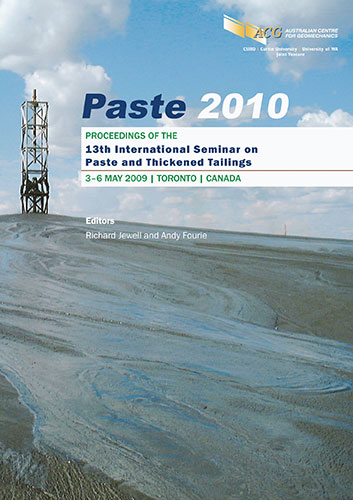Application of paste technology to mitigate the dust emissions from handling of fly and bottom ash at coal fired power plant — CGTEE in Candiota, Brasil

|
Authors: e Silva Marques, M; Lima, H; Mandl, B; Francoeur, R; Palkovits, F; Blois, R |
DOI https://doi.org/10.36487/ACG_rep/1063_7_eSilva_Marques
Cite As:
e Silva Marques, M, Lima, H, Mandl, B, Francoeur, R, Palkovits, F & Blois, R 2010, 'Application of paste technology to mitigate the dust emissions from handling of fly and bottom ash at coal fired power plant — CGTEE in Candiota, Brasil', in R Jewell & AB Fourie (eds), Paste 2010: Proceedings of the Thirteenth International Seminar on Paste and Thickened Tailings, Australian Centre for Geomechanics, Perth, pp. 73-82, https://doi.org/10.36487/ACG_rep/1063_7_eSilva_Marques
Abstract:
During the coal combustion at Companhia de Geração Térmica de Energia Elétrica (CGTEE), a thermal power plant, located in Rio Grande do Sul state in the South of Brazil, fly ash and bottom ash are generated. At the present time, the fly ash collected in a dry form from several points inside the plant, is pneumatically conveyed to storage silos. Bottom ash is saturated with water and conveyed to storage silos by either a water injection pipeline or conveyor transport system. Fly ash reclaimed from the storage silos, after being moistened with water in a mixer, is loaded into open box dump trucks. Bottom ash from silos is transported in open box dump trucks as well. Both are transported approximately 6.5 km to a disposal area in the adjacent surface coal mine. Inside the power plant the air slide and air lift systems are the largest generators of airborne ash. During the transportation and disposal processes, due to the presence of climatically typical high winds, fly ash becomes dry and airborne, resulting in dust emissions. The quenched bottom ash also contributes to airborne ash issues. The deposition methodology in the disposal area allows the dry ash to remain exposed to the environment for a long period of time and makes it susceptible to entrainment in the wind. Resulting dust is transported long distances causing significant environmental issues to the surrounding area. This paper presents the solution proposed to obtain a sensible reduction in dust emissions generated in the ash handling process inside, as well as outside, the power plant property. The proposed solution was to reduce the airborne ash emissions by the creation of low density fly ash slurry in localised mixing tanks within the power plant. The mitigation method investigated includes pumping of the low density slurry to an ash conditioning plant where the slurry will be mixed with bottom ash, followed by dewatering and densification. The densified slurry produced will be pumped to the adjacent coal mine’s disposal area for backfilling in mined areas, thereby eliminating the environmental issue of dust emissions.
© Copyright 2025, Australian Centre for Geomechanics (ACG), The University of Western Australia. All rights reserved.
View copyright/legal information
Please direct any queries or error reports to repository-acg@uwa.edu.au
View copyright/legal information
Please direct any queries or error reports to repository-acg@uwa.edu.au